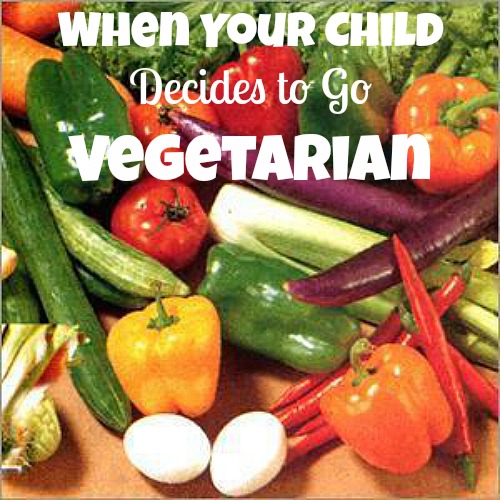The Protein Challenge
I have often described my teenage daughter as a party looking for a place to happen. She’s lighthearted and funny, and her interests can change as often as the weather. So when she popped into the kitchen while I was cooking dinner one night and announced that she was going to be a vegetarian, it was not exactly a stop-the presses kind of moment for me.
We talked a little about the pros and cons of a vegetarian diet, and why she wanted to try it. It turns out that she and her two best friends had decided this together. It didn’t hurt that the lead singer of their favorite band was a vegetarian, but that only added to my impression that it was just a passing fad. I figured they’d cave the first time somebody offered them a slice of pepperoni pizza.
That was nearly three years ago.
As a few weeks passed and it became obvious that she was more serious than I had realized, I went into “negotiation mode”. First, I told her I would do whatever I could to support her, but I would not cook separate meals for her. That means when it’s feasible I adapt what I’m cooking for the rest of the family so that her portion is meat-free. It’s easy enough to prepare a big pot of pasta sauce and scoop out her portion just before I add the meat. Same with soups and stews. If I can’t adapt a recipe, she is responsible for preparing her own meals. And it can’t be macaroni and cheese with a side of fries – that one bummed her out a little. The nutritional value has to include more than carbs.
Second, I insisted that she still eat eggs, fish and dairy products. I know there are those who say this is not a true vegetarian diet. I also know it’s possible to get adequate nutrition from a plant-only diet, but it’s practically a science. Honestly, I work full-time and like most families we are often rushed at mealtime. Eggs, fish and dairy are quick and versatile and give a huge nutritional bang for the buck. Besides, I don’t think she could give up cheese anyway (see mac & cheese comment above).
Finally, we went into “research mode”. I’m a librarian so this part would have been easy for me, but I wanted her feel a sense of responsibility for her own choices. I had her look up the USDA guidelines for nutritional intake. Then we took it a step further and researched protein needs for someone with her activity level. This was where it got interesting.

My vegetarian child is also a two-sport athlete. She’s a soccer fiend – rec soccer in the fall with a community league, and varsity soccer in the spring at her high school. She also holds a blue belt in Brazilian Jiu Jitsu and has several regional championships in her weight class. Since there’s no “Jiu Jitsu season” this requires year-round training, and it’s intense. Based on her weight, age and activity level, this put her daily protein requirement at a jaw-dropping 98-120 grams, depending on which source we used.
Our next step, naturally, was to research good non-meat sources of protein. Not surprisingly, these included fish, eggs and dairy; seeds, nuts and nut butters; tofu and other soy products, and peas, beans and lentils. However, most beans don’t have all the amino acids required to make a complete protein. Combine beans with rice, though, and you magically have a complete protein. Without getting bogged down in the technicalities, think of Mexican and Cajun-style foods as complete proteins – really, any meal that combines rice and beans.
I was surprised to learn that whole grains can be a good source of protein. Yep, that means bread has protein, which is good news to us carb junkies. A regular-size slice of bread has about 4 grams. Cooked brown rice has 5 grams per cup, and it’s so simple to throw a little rice into a soup or stew without changing the flavor or character of a dish. The real powerhouse here, though, is quinoa. If you’ve never tried it, it’s similar in size and texture to barley, and like rice and barley it can be used as a main ingredient or an addition to practically anything. One cup of cooked quinoa provides a whopping 18 grams of protein and nine grams of fiber.
Now, almost three years later, my daughter is nearly 18 and thriving. To be honest, she never ate much meat anyway. She’s what I call a “texture eater”, and something about the mouth-feel of meat always put her off a little. So she hasn’t really missed it, although she’s been known to experience a moment of weakness at the smell of bacon cooking. As for me, after the initial learning curve, having a vegetarian in the house has been easier than I expected.
I can now adjust, adapt and improvise without spending extra time or money.
We even have a few recipes that the die-hard carnivores in our household appreciate. Try them out, or experiment on your own, and you’ll probably be surprised at how easy and tasty it is to have a meatless meal once in a while.
Do you have any creative suggestions or recipes for incorporating more proteins into your diet, without turning towards poultry or meat?
By day, Kathy Pillatzki is a public library administrator and writer. Evenings and weekends find her juggling a busy family and a household full of three teen daughters, pets, friends and food! When I (Jen) heard how she approached her daughter’s decision to choose a vegetarian lifestyle, I knew it would be an interesting topic for Tasty Tuesday, especially since I am always looking for healthy ways to incorporate protein into my own family’s diet. Our growing teen boys need a lot of protein in their diet, but I’m hesitant to just load up the meat and enjoy incorporating similar ideas to Kathy’s .
Thanks for the great suggestions, Kathy.



that is amazing that you supported your daughter in her decision to be vegetarian. i find it odd that you told her she had to eat fish, eggs, and dairy. eggs and dairy i understand but the fish i didn’t. i understand the health benefits but an animal is animal. i never like the idea of eating eggs anyway. i just thought it was weird eating babies. not my thing. i am almost 30 and my family never understood why i am vegan. when i was a child they would order kids meals for me and i would eat the breading off the chicken nuggets and leave the meat in the box. if chicken was on the bone i couldn’t eat it because it reminded me to much of our bodies. plus what was the difference between eating a chicken, cow, or fish and eating a cat or dog. i know people wont agree with me saying that. but i think if it has blood, bones, flesh, hearts, hair, brains, feelings, and basically everything we have it is kinda like eating something alive and we are alive and i don’t like the idea of someone eating us. so i don’t want to do it to someone else. i do not judge anyone on their lifestyle decisions and i hope people can stop judging me. thanks for doing a post on a controversial topic.
Thanks, for the feedback, Abigail. I really think that honest dialog like this goes a long way towards promoting understanding of different dietary choices. In our case, her decision wasn’t so much about the ethics of eating (or not eating) animals. If it had been, I might have approached it differently. After a lot of discussion with her, it turns out it really is just a personal preference. She doesn’t care for the taste or texture of meat. However, tuna is one of the few things she really loves, so I didn’t want to eliminate that from her diet since it is such a good source of protein, and also a quick and easy meal option for her. I admire your principles though, because as a child I’m sure it was hard to explain and resist the expectation that you would do what everybody else was doing.
Great post! Would love for you to share some of your “go to” veg recipes in a future Tasty Tuesday post.
We will make sure and do that. 🙂
I started cutting back on meat when I was 10, and I was completely vegetarian by age 14 (including no fish, which I never liked because I don’t care for bones in my food). That was nearly 25 years ago now. There are SO many more veg-friendly restaurants and grocery options now than there were back then! My mom wasn’t quite sure what to do about it, and I know I ate quite a few cans of vegetarian vegetable soup. Combining amino acids in your meals to form complete proteins isn’t actually necessary. Your body will automatically do that on its own. Ground up chickpeas are a great way to add protein and fiber to a simple spaghetti sauce. Add in some whole grain pasta, and you have a complete protein. Easy peasy. I highly recommend a whole foods diet as much as possible (as opposed to pre-packaged meat subs and tofu). Mushrooms and chickpeas can surprisingly replace meat in a lot of recipes. And both are very good for you!
The ground chickpeas are a great idea! I hadn’t thought of that. And you’re so right about mushrooms. Sometimes when we grill out, we buy a couple of Portobello mushrooms and grill those for my daughter. Brush them with a little olive oil and sprinkle on a little garlic salt and parmesan cheese, and she has to eat fast before everybody at the table asks for “just a bite” of hers!
I have to say how amazing it is to hear this story of such support for your daughter! It’s wonderful! And how great that it wasn’t really that hard to accommodate with the rest of the family’s meals!
Thanks, Jennifer! I’ve always tried to let my kids try new things… as long as it’s not illegal, immoral, or crazy dangerous…. and doesn’t require me to take out a second mortgage! LOL
It’s nice to hear that you supported your daughter’s choice to not eat meat. Not every parent would understand or be so accommodating.
I second the comment about protein complimenting with rice and beans. From what I’ve read, the current thinking is that not all amino acids need to be present at every meal, just average out in general.
Our family is omnivorous, but eats very little meat. My husband also has a physically strenuous job, and I still am able to fulfill his nutritional needs with mostly vegetarian fare. I was a vegetarian in college, but started eating meat again when I moved to the deep south for graduate school and wanted to sample all the culinary pleasures S. Louisiana had to offer, but have never totally gone back to my pre-college eating habits. (My youngest raised a market lamb for FFA last year, which is now in a friend’s freezer, so we are truly not a family averse to meat.)
For a growing boy who needs to keep his weight up, you can make a lot of things like chili, red beans and rice, cassoulet (I use beans, chicken and sausage in mine), homemade hummus as a sandwich spread, noodles with peanut sauce, veggie lasagne, bean burritos, veggie burgers instead of beef, split pea soup. Grain dishes like risotto, jambalaya, paella, polenta with sauce are also good, as well as lesser known grains like farro and quinoa, which I frequently find marked down, maybe because they are sort of unusual. Add vegetable fats by cooking with olive oil, and adding avocados and nuts and seeds to salads, pasta dishes, etc. (We are nut farmers, so that is more affordable for us than for most families). Fortunately, lots of recipes that call for beans are crock-pot and freezer friendly. I always soak beans overnight before cooking to speed cooking time and aid in digestibility. Also, I make my own whole plain beans, as well as refried beans to freeze for later, since they are time consuming to cook.
Whew! That was a long list. Hope you all can make sense of it. Also, the internet is a fantastic resource for recipes.
Thanks for the info about the amino acids averaging out, that’s good to know!
Hi, First, I think you daughter is incredibly wise for her young age. I have been slowly going of meat for some time but my husband is a bsic meat & potatoe’s eater so I still cook meat for him…steak, burgers, chicken, some pork and eat it as a side dish. But that is about to change.
I watched the movie ‘Forks and Knives’ last night of Hulu. I wasn’t really surprised at the scientific conclusions that were presented as my intuition was already telling me to eat a vegan diet. Yet it just seemed a bit to much as I love cream in my coffee and my husband makes the best scrambled eggs ever! By the end of the movie I was convinced!
Something I have added to my diet years ago is miso. Culturally is is an ingredient that Japanese soup. But I use it to make tea, melted on pasta, included in homemade salad dressing…etc. And my favorite breakfast green smoothie recipe is below.
1 c spinach
1 c kale
1 orange
½ a banana
½ green grapes
Lemon juice from ½ a lemon
sprinkle of chia seeds
1/8 tsp flax seed oil
4 ice cubes
1 ½ c orange juice or enough to provide for a smooth texture
I use a commercial blender but a food processor is fine.
Happy breakfast!
Thank you for adding this in about miso. I’ve recently been reading up on it, but haven’t used it yet in any recipes. Off to be a bit more experimental. 🙂
@Jen, Have fun. I started using miso years ago when I lived in Vancouver, B.C. is an environment that was so much more supportive of alternative ways of eating. It’s fermented soy beans…your body receives vital living enzymes great for digestion, also great for your immune system. and of course very high in protein. When I was in art school, I would add it to top ramen with frozen peas…vry affordable, tasted great and my body loved it! These days…living with a bit of stress…it’s my go to stress reliever…just melt it in hot water and the tea (of sorts) is extremely soothing and very healthy. Happy experimenting! d
Great ideas! Hadn’t thought of miso. Thanks!
I first became a vegetarian when I was 16. My mom wasn’t very supportive of me and after a year she made me eat meat again. A few months ago, I stopped eating meat again for good. I’m almost 19 now, and since I make my own money and can pay for anything that might be considered “extra” on the grocery bill. I think it’s wonderful that you supported your daughter, because I’m sure that helped her with her decision a lot. My mom had been one for 7 years so I don’t understand why she’s been against me doing it. Anyway, I can’t wait to see more posts from you!
I love your story because it reminds me of my own vegetarian story 🙂 I was 14 when I announced to my parents that I was going to become a vegetarian, and my parents reaction was very similar. Skeptical, but supportive. They too insisted that if I was going to do it, I had to do it right and eat a healthy diet. As they began to see that I was serious, they only became more supportive. That was 15 years ago and I’m still a healthy vegetarian, raising 3 super healthy vegetarian children.
Not all parents are so supportive, so it makes me happy to know there are parents out there supporting their kids in a decision that can have so many positive health benefits. One thing that helped me stay on track for 15 years is that I love to cook and try new foods. Check out ethnic cookbooks: Italian, Mexican and Indian cookbooks have lots of vegetarian recipes.
Hummus with pita chips or veggies makes a great snack and falafel is one of my favorites. Lentils are great in Shepherd’s Pie.
Red lentils are great with rice or in soups.
Greens and beans pack a lot of protein into a side dish.
Adding black beans to Nachos will add some extra protein.
My general rule of thumb in meal planning is to include some combination of whole grains, legumes and vegetables. At least 2 of the three in each meal will provide the complimentary amino acids for your body to make complete proteins.
Thanks so much for sharing your experience. I always love reading all the suggestions. 🙂
My best friend is a vegetarian and one of my favorite standbys when she comes over is meatless tacos! All you do is buy vegetarian chili in a can (I always make sure to have one around) heat it up and add it to taco shells! My husband and I usually add ground beef to ours but it’s a healthy treat 🙂
Thank you for writing this. My 8 year old told us last week while in the meat department of the grocery store she would no longer be eating meat. I appreciate your approach, as I am also a working mom. Hoping to employ some of these tips as we employ a vegetarian aspect of our house.
Thank you for a great blog. My 16 year daughter has also announced she is a vegetarian. she has made this decision a couple times before. She doesn’t eat meat very often. she stopped eating pork years ago. I have researching recipes and how she will be all the nutrients. I have a Culinary Arts, so making ordinary meals and changing into vegetarian meals is easier. I did learn RICE and BEANS for protein?? WOW! Just wanted you know I will be checking every now and again.
Thanks so much, Deb. Best of luck with feeding your sweet vegetarian. It’s challenging and takes extra time, for sure, but sounds like you know what you are doing. 🙂
My daughter is 10 Years Old and a few weeks ago decided she would like to be a vegetarian. Like your daughter she has never been a big meet eater so it wasn’t a huge shock but as a family of big meat eaters I was worried. Most recipes are easily adapted but I do worry about her protein intake. She hates eggs and beans so I really struggle to find ways to get protein into her. Any recipes would be gratefully appreciated. As a mother I feel we should support our children and encourage them to know their own mind. My daughter never really liked meat but her choice is more principled on not killing animals. We talked through her thoughts and we (daddy and I) explained that we would still be eating meat and our daughter wasn’t too pleased but agreed that it is our choice. She asked that her meals be prepared separate to meat containing meals so separate utensils and pans where bought and she is happy with that. She has also become more interested in cooking as she likes to know what she is eating. Personally I don’t know how she can resist bacon though lol
I’m with you on the bacon!! It’s amazing that she is taking this stance at such a young age. I’ll think through some recipes and see if I can lead you to some. Will she eat eggs when it’s in a recipe, like a baked kind of item?